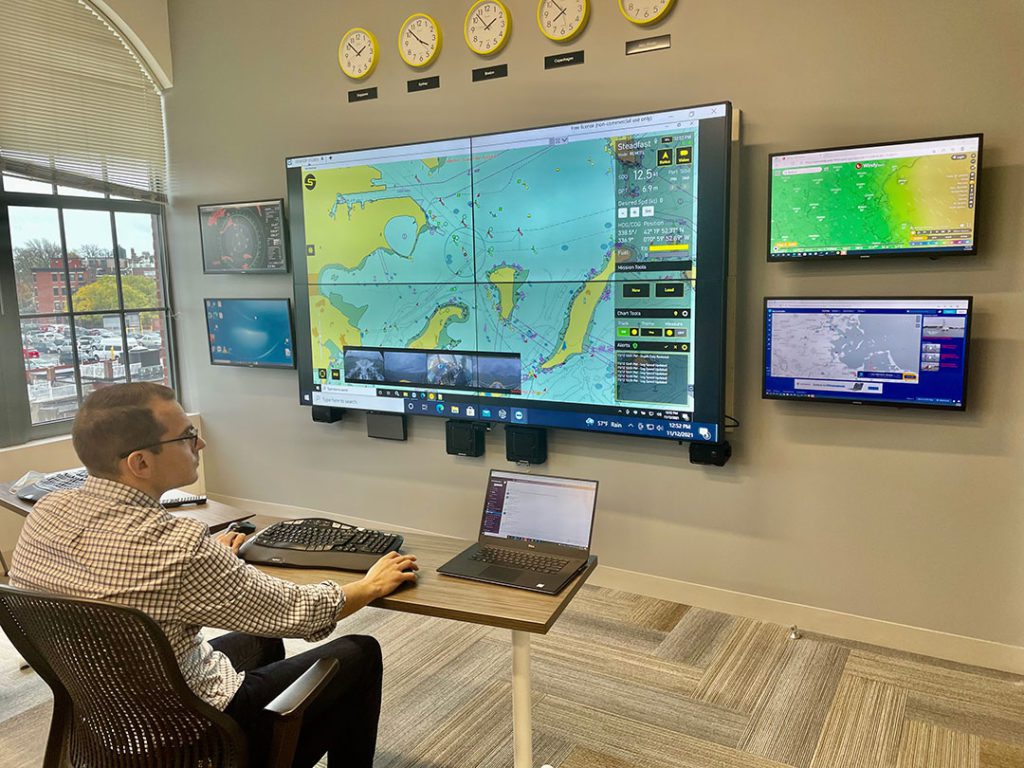
Capt. Bill Powers watched as the 25-foot aluminum launch Steadfast chugged ahead on a gray New England afternoon. With a few clicks of his computer mouse, he changed the vessel’s speed and course across Quincy Bay.
Steadfast did as he requested almost immediately. Its twin Honda outboards slowed in preparation for a sharp turn to port. The engines roared back to life once the vessel executed the turn.
“It automatically reduces speed to the safest turning radius possible while keeping the vessel on track,” Powers explained.
He watched all this from a command center in Sea Machines’ downtown Boston headquarters. Steadfast, meanwhile, was more than five miles away. Its test captain, Ben Galdo, stood by as the vessel responded to remote helm and throttle orders.
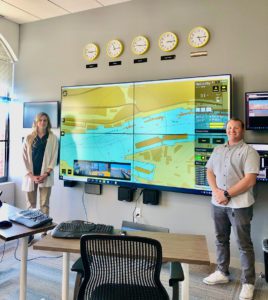
Powers and Galdo work for Sea Machines, the Boston-based autonomous technology company. Steadfast is equipped with its SM300 autonomy system that enables remote monitoring and remote control from across town or around the world.
Michael G. Johnson, Sea Machines president and chief executive officer, started the company in 2015 after a 20-year maritime career. He previously worked for Crowley Maritime Corp. and its affiliate Titan Salvage. During that time, he supported the salvage plan for raising the sunken cruise ship Costa Concordia in Italy.
He said the maritime industry is just now starting to embrace the benefits of data and technology to improve vessel operations. He believes automation can make commercial operations safer and more efficient.
“Being mariners,” he said, “we understand that much of the time on vessels is very routine. And that is where humans are not always at their best. In these long durations, humans can get fatigued whereas a computer system does not.”
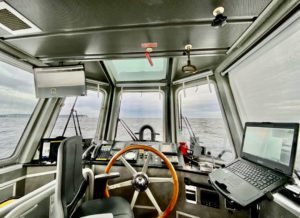
Automation explained
Automation can mean different things to different people. It can describe the autopilot feature on a plane, which does most of the flying these days. Or, in the automotive industry, it can mean lane-assist technology or self-driving capabilities.
In the maritime sector, the term often connotes a future with fully unmanned vessels, and there are efforts regarding full automation that are gaining momentum. Yara International is pursuing unmanned shipping in Norway with its 262-foot containership Yara Birkeland. But automation can also refer to the autopilot function on a tugboat or ferry.
Sea Machines’ SM300 is one of its primary autonomous operations systems. It consists of powerful software and computing equipment that utilize numerous sensors and data inputs to understand a vessel’s surroundings and make decisions accordingly. Those can include remote operations, as Powers demonstrated in Boston, or remote monitoring of vessels half a world away.
“Autonomy is multiple sensors coming in and being able to prioritize all of that data that is available to them,” Johnson said. “The command is always by a human. Whether that is a mate, a captain or a helmsman, that person is in command.
“The autonomy system is able to take direct effort off the human, but still that autonomy system is under the command of the person in charge,” he continued.
Instruments that feed into the computer program include radar, AIS, digital charting, propulsion and steering, and depth and weather sensors. Additional sensors can monitor or control other key systems as desired by the operator, such as those limiting heave or pitch in rough seas. Future advances will integrate cameras into a system that can recognize different features on the horizon.
Collecting the data is only one piece of the equation. The SM300 system interprets the data almost instantly, in real time, through an autonomy computer. The software is programmed to follow international anti-collision rules, and it can make decisions on different parameters set by the captain or crew.
The hardware is stored on the vessel in a unit roughly the size of a dorm-room mini fridge. Communications between the vessel and the remote location can occur via satellite during ocean transits, or via 4G signal if a vessel is close to land.
Gaining a foothold
Sea Machines is by no means the only company developing this technology. Kongsberg, in Europe, outfitted the unmanned Yara Birkeland with an advanced suite of sensors, along with automation, integration and communication systems.
The all-electric, zero-emissions ship completed its first voyage last fall. It left the Norwegian town of Horten in the morning and arrived in Oslo that evening. The voyage signaled the start of a two-year testing period for the ship. During that time, it will transport fertilizer between two Norwegian ports southwest of Oslo.
“The project demonstrates how we have developed a world-leading innovation that contributes to the green transition and provides great export opportunities for Norwegian technology and industry,” Geir Haoy, CEO of the Kongsberg Group, said in a statement.
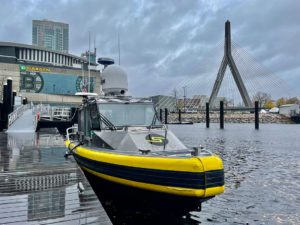
vessel Lightning.
Here in the United States, the military has actively pursued automation technology. Metal Shark won a contract last year to develop the Long Range Unmanned Surface Vessel (LRUSV) for the U.S. Marine Corps. The system uses autonomous technology developed by Spatial Integrated Systems. Huntington Ingalls Industries acquired the company’s autonomy business late last year.
“The LRUSV program represents a significant milestone for autonomous technology, for the defense world, and for the entire shipbuilding industry,” Metal Shark CEO Chris Allard said last year. “We are thrilled to be integrating advanced autonomy and command-and-control capability into these highly specialized surface vessels to provide the Marine Corps with a next-generation system.”
The Marine Corps contract builds on Metal Shark’s Sharktech Autonomous Vessels division, launched in 2018, that has contracts with the U.S. Coast Guard and other military branches. Metal Shark has partnered with Sea Machines on some of these projects.
Proof of concept
Sea Machines’ SM300 technology is the result of thousands of hours of testing on the water. The company operates a small fleet of vessels that run almost every day in and around Boston Harbor. The test captains put the software program, and the vessels, through their paces looking for potential flaws in the software.
“They test all day long, essentially trying break it and find bugs,” Powers said. “They have direct communications with the software engineers so they can log bugs as they find them, and then they are tracked, fixed and tested.”
Sea Machines put its SM300 system through the ultimate test last fall. The tugboat Nellie Bly completed an autonomous journey around Denmark that spanned more than 1,000 nautical miles. Licensed mariners from the American Maritime Officers (AMO) union controlled the vessel remotely from the company’s Boston office.
Nellie Bly was equipped with a broad suite of technology to complete the voyage. That included radar, AIS, GPS and sensors measuring depth, weather, roll-pitch-heave and engine readings. Cameras fed images back to the AMO officers in Boston as well as into the SM300 system for collision avoidance. The officers monitored the vessel from the control room using a large screen, with smaller screens showing vessel performance, weather, charts and other data.
Powers, along with Capts. Steve Turano and Artie Seaman, stood watch in the wheelhouse for much of the day. The voyage took the tug through open water and narrow, busy waterways such as the Kiel Canal. The autonomous system did the steering each step of the 13-day voyage.
Powers and his colleagues on the vessel kept a careful watch and remained in close contact with mariners at the Boston office throughout the voyage. But using the SM300 system sharply reduced their workload while underway.
“I can tell you, from years of actually standing on the bridge and staring out the window, I was much less fatigued at the end of the day with the autonomy system,” said Powers, who served in the Coast Guard and holds a 100-ton master’s license.
“You might just be standing in a 10-foot area on the bridge, but you are using a lot of processing power,” he said. “It is just a lot of mental work.”
Automation in the U.S.
There are currently no formal regulations in place governing the use of automation on commercial vessels in U.S. waters. The Coast Guard requested public comment in 2020 on automation and autonomous technology but has not developed new protocols.
“The Coast Guard is still considering developing a policy or regulations on automated and autonomous commercial vessels,” spokesman Kurt Fredrickson said. “No formal decision has been made yet.”
As a result, the autonomous systems currently in use in the U.S. were approved on a case-by-case basis. Sea Machines has installed dozens of systems on vessels around the world. One example is an American survey company that placed a system on a smaller vessel that is controlled by the mother ship.
“Survey companies will be the first to tell you that a crew change is one of the most dangerous things they do at sea,” said Johnson, the Sea Machines CEO. “And with an autonomy system, it allows them to keep the vessel working and the propellers turning and have a much more productive operation.”
Foss Maritime outfitted its latest ASD90-series tugboat Rachael Allen with an SM300 system, and First Harvest Navigation installed a similar system on its 63-foot delivery catamaran Captain Ben Moore. The system includes collision avoidance and obstacle detection capabilities.
First Harvest Navigation is awaiting final Coast Guard approval to begin operating with the SM300 system, according to owner Bob Kunkel. At this point, he does not expect manning levels will change once the system is operational.
“We are first going to look at it as a secondary safety measure of navigation,” Kunkel said in a recent interview. “Does it provide the next level of safe navigation using AI (artificial intelligence) and also allow crew to leave the pilothouse and work other issues on the boat?”
Captain Ben Moore, a hybrid catamaran built by Derecktor Shipyards, typically operates with three crewmembers as it delivers produce and meat between New York and Connecticut. Kunkel envisions crew handling other tasks while underway, such as preparing cargo for offloading to save time and improve efficiency at the dock.
Concerns about automation
Wider adoption of maritime automation makes some mariners nervous. Just as self-scanners at the grocery store and self-ordering kiosks at McDonald’s have eliminated some jobs, there is concern that a similar trend could play out in the maritime industry.
Last fall, the International Longshoremen’s Association announced it will not work unmanned cargo ships that call on ILA ports. “The ILA will not work a containership without a crew aboard,” ILA President Harold Daggett said. “Already one company developing these automated ships (is also planning) for automated loading and unloading of cargo from these crewless ships without workers. That’s not going to happen under my watch.”
Others take a more nuanced view of the technology. Capt. Marc Deglinnocenti considers AI systems to be a valuable tool in the wheelhouse. He cited studies in the U.S. and Germany showing that 90 percent of vessel collisions involve some form of human error. But he is wary of vessels pursuing reduced or completely unmanned operations.
“There are many other pressing needs for crews to remain on board,” he said in an email. “Only a few of which are repairing vessel breakdowns, anti-piracy, strategic hands-on firefighting, collision damage control, complying with international treaties to render aid to vessels in distress, and routine maintenance. The list goes on.”
Human control
Back in Boston at Sea Machines headquarters, Powers opened the laptop that controlled Steadfast in Quincy Bay. The user interface lets operators set numerous parameters for any voyage. These include speed, proximity to other vessels, and depth and roll-pitch-heave limits. Each can be set with a couple of clicks and updated at any time during the voyage.
Powers initially set Steadfast for a slow looping route around the bay using a series of waypoints. Midway through he changed some waypoints, which changed the route. He also increased the speed. The laptop on Steadfast made a sound to denote the route change.
Before long, the demonstration ended and Galdo resumed his testing efforts on the bay. Meanwhile, another Sea Machines test vessel, Lightning, returned to a dock outside the company office.
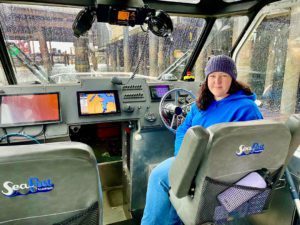
Boat operator Jennifer Stockbridge joined Sea Machines last fall after working for Boston Harbor Cruises. Her previous vessel lacked autopilot, and a month into the job she was still acclimating to Sea Machines’ remote-control capabilities.
She likened her job performing rigorous testing to that of a traditional training captain.
“You just have to watch where it goes, watch how it reacts and watch what it does and see if you can give feedback to the engineers,” she said. “Even driving a car, I like to be the one driving, so to let that part go has been a little bit of a learning curve.” •
